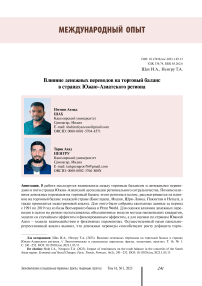Влияние денежных переводов на торговый баланс в странах Южно-Азиатского региона
Автор: Шах Имтияз Ахмад, Ненгру Тарик Ахад
Журнал: Экономические и социальные перемены: факты, тенденции, прогноз @volnc-esc
Рубрика: Международный опыт
Статья в выпуске: 1 т.16, 2023 года.
Бесплатный доступ
В работе исследуется взаимосвязь между торговым балансом и денежными переводами в пяти странах Южно-Азиатской ассоциации регионального сотрудничества. Помимо влияния денежных переводов на торговый баланс этого региона в целом, рассматривается их влияние на торговый баланс в каждой стране (Бангладеш, Индия, Шри-Ланка, Пакистан и Непал), а также проводится межстрановой анализ. Для этого были собраны ежегодные данные за период с 1991 по 2019 год из базы Всемирного банка и Penn World. Для оценки влияния денежных переводов в целом на регион использовались объединенные модели метода наименьших квадратов, модели со случайным эффектом и фиксированным эффектом, а для оценки по странам Южной Азии - модели взаимодействия и фиктивных переменных. Осуществленный нами панельнорегрессионный анализ выявил, что денежные переводы способствуют росту дефицита торгового баланса пяти южноазиатских стран. Другие контрольные переменные, например обменный курс, прямые иностранные инвестиции, внутренние инвестиции и человеческий капитал, оказывают существенное негативное влияние на торговый баланс. С другой стороны, рента от природных ресурсов положительно воздействует на торговый баланс стран Южно-Азиатской ассоциации регионального сотрудничества. Модель взаимодействия фиктивных переменных подтверждает негативное влияние денежных переводов на торговый баланс в Индии, Непале и Пакистане, в то время как в Бангладеш и Шри-Ланке оно незначительно. В работе представлены возможные последствия для анализируемых стран.
Денежные переводы, торговый баланс, южная азия, панельные данные
Короткий адрес: https://sciup.org/147240284
IDR: 147240284 | DOI: 10.15838/esc.2023.1.85.13
Список литературы Влияние денежных переводов на торговый баланс в странах Южно-Азиатского региона
- Akoto L. (2019). Empirical analysis of the determinants of trade balance in post-liberalization Ghana. Foreign Trade Review, 54(3), 177–205.
- Alferi A., Havinga I., Hvidsten V. (2005). Definition of Remittances and Relevant BPM5 Flows. New York: Statistics Division, United Nations.
- Barro R., Sala-i-Martin X. (2004). Economic Growth. 2nd edition. Cambridge, MA: MIT Press. Bhattacharya S.K., Das G.G. (2014). Can South–South Trade Agreements reduce development deficits? An exploration of SAARC during 1995–2008. Journal of South Asian Development, 9(3), 253–285.
- Bjorvatn K., Farzanegan M.R. (2013). Demographic transition in resource rich countries: A blessing or a curse? World Development, 45, 337–351.
- Bouhga-Hagbe J. (2004). A theory of workers’ remittances with an application to Morocco. IMF Working Paper, 04, 194. Washington D.C.: International Monetary Fund.
- Falk M. (2008). Determinants of the Trade Balance in Industrialized Countries. FIW Research Report 13. Vienna.
- Farzanegan M.R., Sherif M.H. (2016). How does the flow of remittances affect the trade balance of the Middle East and North Africa? SSRN Scholarly Paper. Rochester, New York: Social Science Research Network.
- Farzanegan M.R., Sherif M.H. (2020). How does the flow of remittances affect the trade balance of the Middle East and North Africa? Journal of Economic Policy Reform, 23(2), 248–266.
- Hasan G.M., Shakur S. (2017). Nonlinear effects of remittances on per capita GDP growth in Bangladesh. Economies, 5(3), 1–11.
- Hasan M. (2003). Export performance of South Asia after trade liberalization in the early 1990s. The Chittagong University Journal of Business Administration, 18, 107–120.
- Khan M.A., Faheem U.R., Hussain F., Razzaq A. (2021). Study on determinants of trade deficit in selected SAARC countries: The role of infrastructure. Indian Journal of Economics and Development, 9, 13.
- Lall S. (2000). The technological structure and performance of developing country manufactured exports, 1985–1998. Oxford Development Studies, 28(3), 337–369.
- Lartey E.K.K. (2018). The effect of remittances on the current account in developing and emerging economies. Policy Research Working Paper, 8498. Washington, D.C.: World Bank.
- Nguyen P.H. (2017). The impact of remittance on trade balance: The case of Malaysia. Journal of Economics and Public Finance, 3, 531.
- Okodua H., Olayiwola W. (2013). Migrant workers’ remittances and external trade balance in Sub-Sahara African countries. International Journal of Economics and Finance, 5. DOI: 10.5539/ijef.v5n3p134.
- Pfaffermayr M. (1996). Foreign outward direct investment and exports in Austrian manufacturing: substitutes or complements? Weltwirtschaftliches Archive, 132(2), 501–522.
- Ramirez M., Sharma H. (2008). Remittances and growth in Latin America: A panel unit root and panel cointegration analysis. Estudios Economicos de Desarrollo Internacional, Euro-American Association of Economic Development, 9(1), 5–36.
- Rifa F., Thahara A.F., Fathima R., Kalideen S. (2021). The relationship between exchange rate and trade balance: Empirical evidence from Sri Lanka. Journal of Asian Finance Economics and Business, 37-0041.
- Sutradhar S. (2020). The impact of remittances on economic growth in Bangladesh, India, Pakistan, and Sri Lanka. International Journal of Economic Policy Studies, 14(3).
- Topxhiu R.M., Krasniqi F.X. (2017). The relevance of remittances in fostering economic growth in The West Balkan countries. Ekonomika, 96(2), 28–42.
- Tung L.T. (2018). Impact of remittance inflows on trade balance in developing countries. Economics and Sociology, 11(4), 80–95.
- Wood A., Mayer J. (2001). South Asia’s export structure in a comparative perspective. Oxford Development Studies, 29, 5–29. DOI: 10.2139/ssrn.189810


